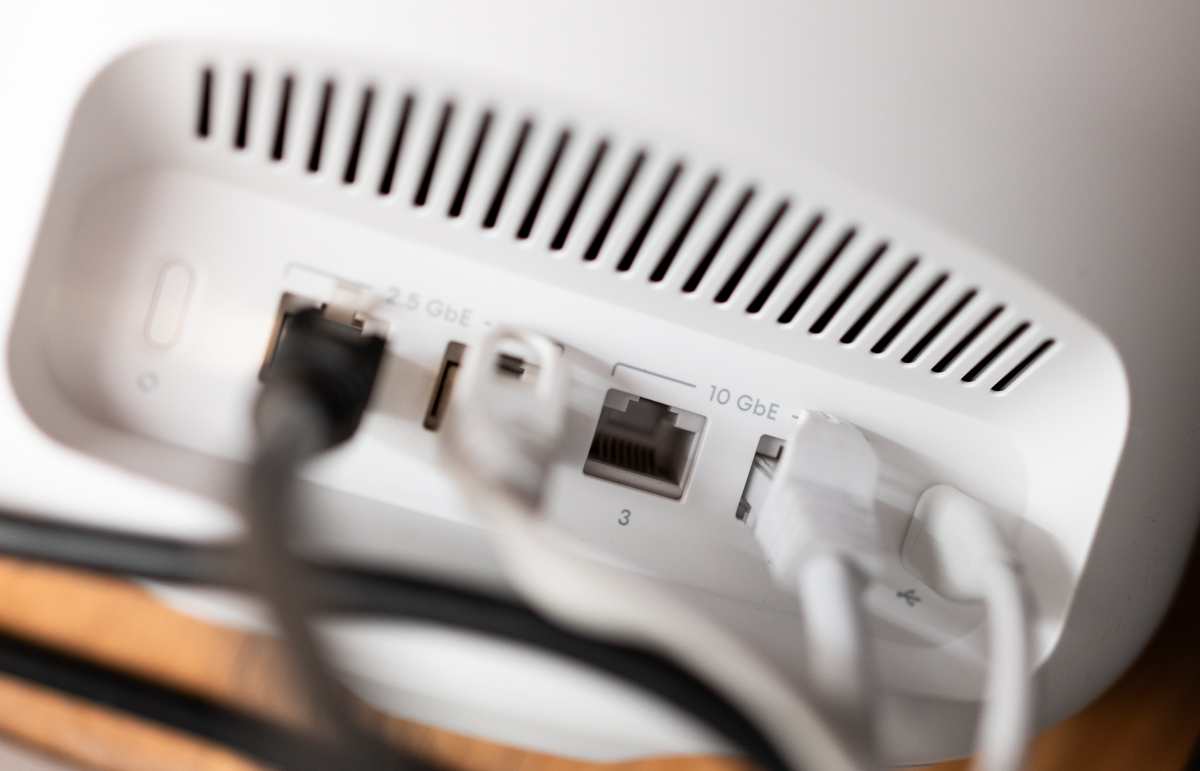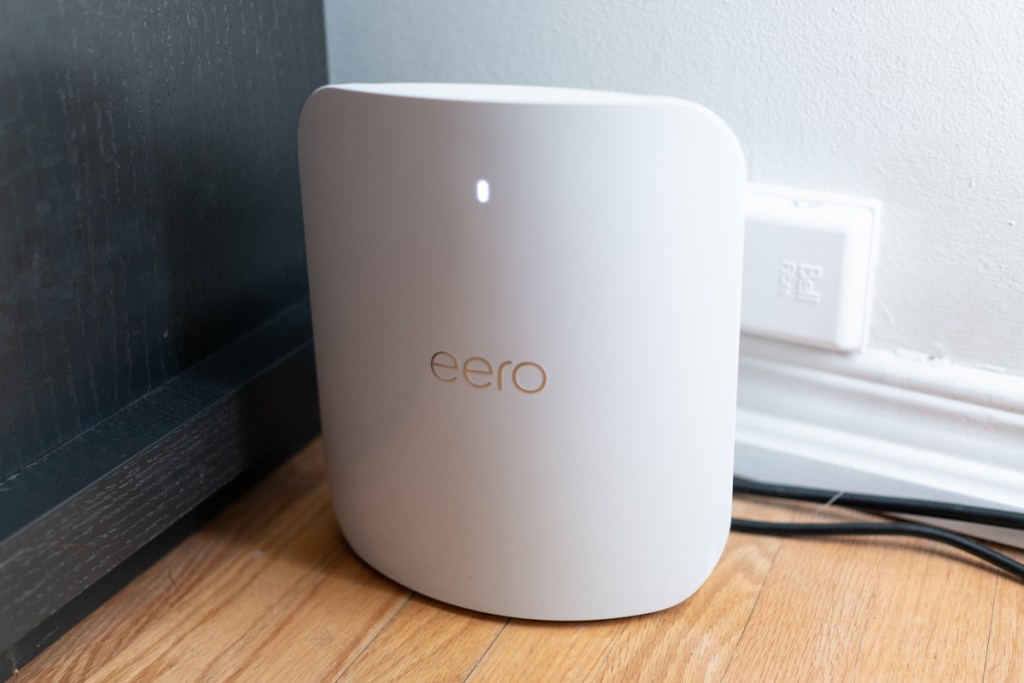Amazon’s eero acquisition continues to bear fruit, and the latest off the vine is the eero Max 7, by far the company’s most advanced router yet, and the most capable when it comes to input and output options, too. The Max 7 supports Wi-Fi 7, the cutting edge in Wi-Fi standards that’s still relatively hard to find in consumer devices, and it also boasts 6 GHz frequency networking for better mesh and local network performance. Will 7 turn out to be a lucky number for eero fans? Read on to find out.
The basics
The eero Max 7 is the company’s fastest yet, either taken individually or in mesh configuration, and provides speeds of up to 4.3 Gbps wirelessly, and up to 9.4 Gbps wired. Each Max 7 has two 10 and two 2.5 GbE ports, which is double the number of physical cable connections that have appeared on any prior eero devices, and at much higher speeds that the standard 1 Gbps ports that have appeared on most prior eero hardware.
Max 7 has support for 2.4, 5 and 6 GHz radio bands, and each promises double the wireless throughput of the existing eero Pro 6e models, with a larger range of coverage, too, thanks in part to a brand new physical design optimized from top to bottom for better performance. Amazon says that a single eero Max 7 ($599.99) can provide coverage for up to 2,500 square feet, while a two-pack ($1,149.99) will span 5,000 and the three-pack ($1,699.99) will cover a massive 7,500.
In terms of smart home compatibility, the eero Max 7 covers a lot of ground, too, including Matter, Thread and Zigbee support.
Design and build
The Max 7 doesn’t look like prior eero hardware, which tended to lean squat and compact. It’s a much more vertical design, with a long convex front face emblazoned with the eero logo. There’s one LED indicator light on the front to give you network and device status updates at-a-glance, and then around back are the four Ethernet ports and single USB-C port, which supports the included 45W power supply and cable.
The new hardware designs are definitely larger overall than any prior eero, but they have a smaller footprint since most of that is built into the extended vertical body. They shouldn’t require a drastic rethink of any placement or decor if you’re coming from older eeros or competing mesh routers, though, and eero’s continued commitment to a very spare, all-white outer case look continues to be one of the best options available when it comes to home networking gear in my opinion.
Amazon tells me that the new design focused a lot on delivering improved thermals for maximum performance, as well as distancing the antennas as much as possible from metal within the case to minimize the potential for interference. There’s a passive cooling system that’s employed to avoid having to use a fan, which the Max 7 designers wanted to do to avoid noise.
For most users, the biggest and most impactful physical design changes will be the four ethernet ports on the back, which are now specced at a minimum speed of 2.5 Gbps. The two 10 Gbps ports basically futureproof these for a long, long time for most people, because it’ll be many years (if ever) before a lot of customers even have the option to get that kind of residential service. I’m on 3.5 Gbps fiber here, and that itself is an extreme rarity — but one that served me well in putting the Max 7 through its paces.

Performance and features
For some context around my experience with eero Max 7, it’s worth noting that I’m already an eero customer. I’ve had the eero Pro 6 set up in a three-device mesh arrangement since they came out, and that replaced an outgoing eero Pro setup. I’ve tried and tested a number of different Wi-Fi networking devices, from a number of companies, including some excellent ones from Google, Netgear and Ubiquity’s AmpliFi, but for my own personal use I keep coming back to eero for ease of use, convenience and reliability.
That came in handy when setting up the Max 7, as I was able to easily add them to my existing Pro 6 setup. There are a number of options eero gives you when doing this, including replacing an existing gateway, or just adding them as new nodes on your mesh network. I chose the latter, and then later after I’d tested them working together with the older hardware (which was flawless, by the way), I swapped out a Max 7 for the gateway Pro 6, and then removed the Pro 6 devices leaving only the two Max 7’s I’d been sent to review to make up my entire network.
I live in a roughly 100-year-old, three-story semi-detached house that’s probably around 2,500 square feet max when you include the basement, so technically I probably could get away with just one, but I’ve always used a three-point setup (I like having the backyard covered, too). The two-point Max 7 network has thus far seemed more than capable to the task of covering my entire house and yard, and I’ve only noticed improvements in terms of network speed and quality versus the three-point 6 Pro setup I’m coming from. Once I return to a personal setup, I may mix the Pro 6 and Max 7 units, since Amazon says both will perform to the best of their respective abilities even in a hybrid network consisting of a variety of eero devices.
Setup was incredibly easy, and I was able to immediately see the benefits. Whereas before my Pro 6 speed test in the eero app itself has maxed out at just under 1 Gbps up and down, as you’d expect from the max limits of the incoming ethernet port, the Max 7 showed around 3.2 Gbps down and around 3.2 Gbps up consistently, which is basically at the rated speed of the line I’m paying for. I then have my work computer hardwired into one of the 2.5 Gbps ports on the Max 7 using a 2.5 Gbps USB-to-ethernet adapter, and I’m showing those speeds nearing the hardware limit on that Mac, too.
Wireless speeds are incredibly improved, with my iPhone 15 Pro Max showing speeds of 1 Gbps down/up — and what’s truly amazing, speeds of nearly 3 Gpbs up/down on the OnePlus 11 5G, one of the first consumer devices available that supports Wi-Fi 7 speeds.
eero also still offers some of the best network management software in the business via their app, which allows you to pause and block device access, set up alerts for new devices joining the network, create guest networks, add admins and much more.
Bottom line
Under Amazon, eero has continued to thrive and deliver on its promise of making mesh networking dead simple and accessible to everyone. The eero Max 7 is definitely a step change in terms of ambition, power and performance — but it manages to deliver excellent results in all of those areas without compromising on ease-of-use. The price reflects the cutting-edge, future-proof nature of the tech under the hood, but the Max 7 will satisfy anyone who can handle the sticker shock.































Comment